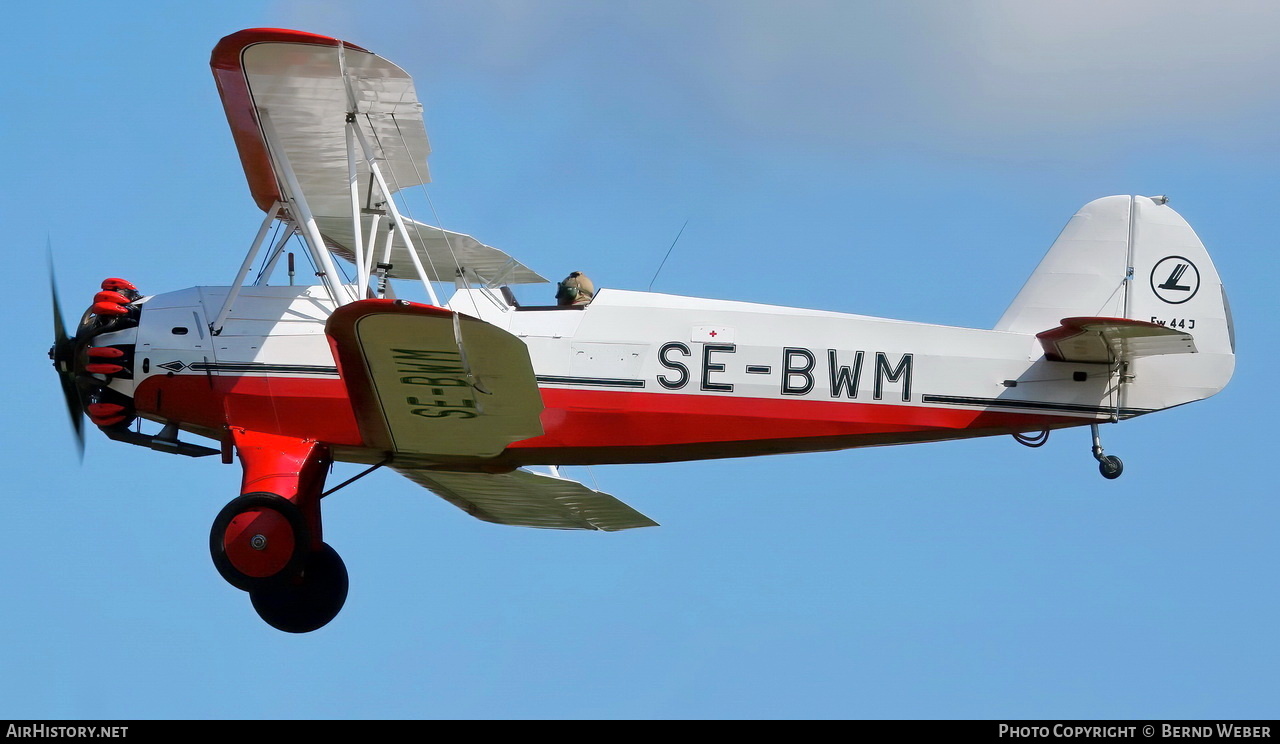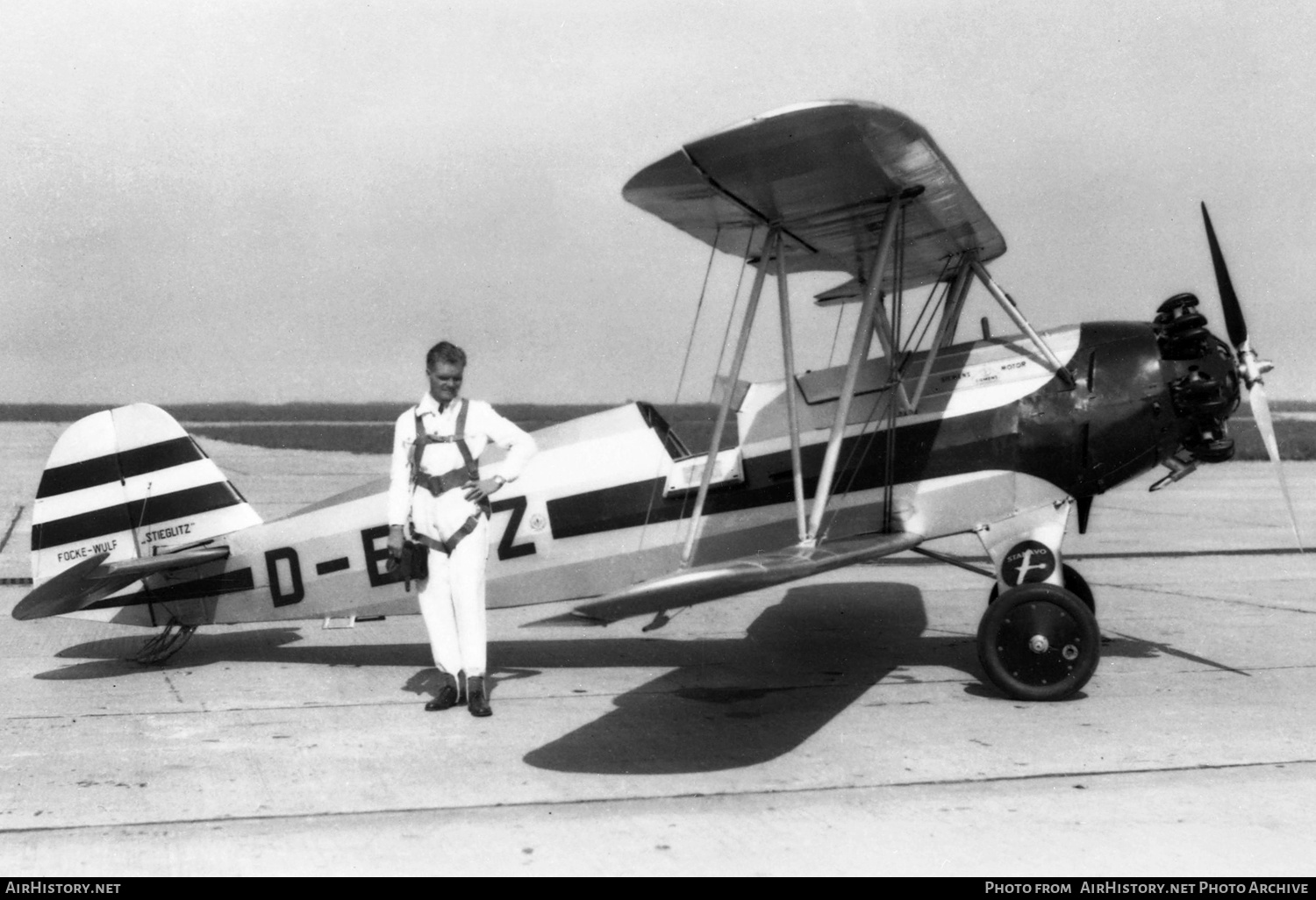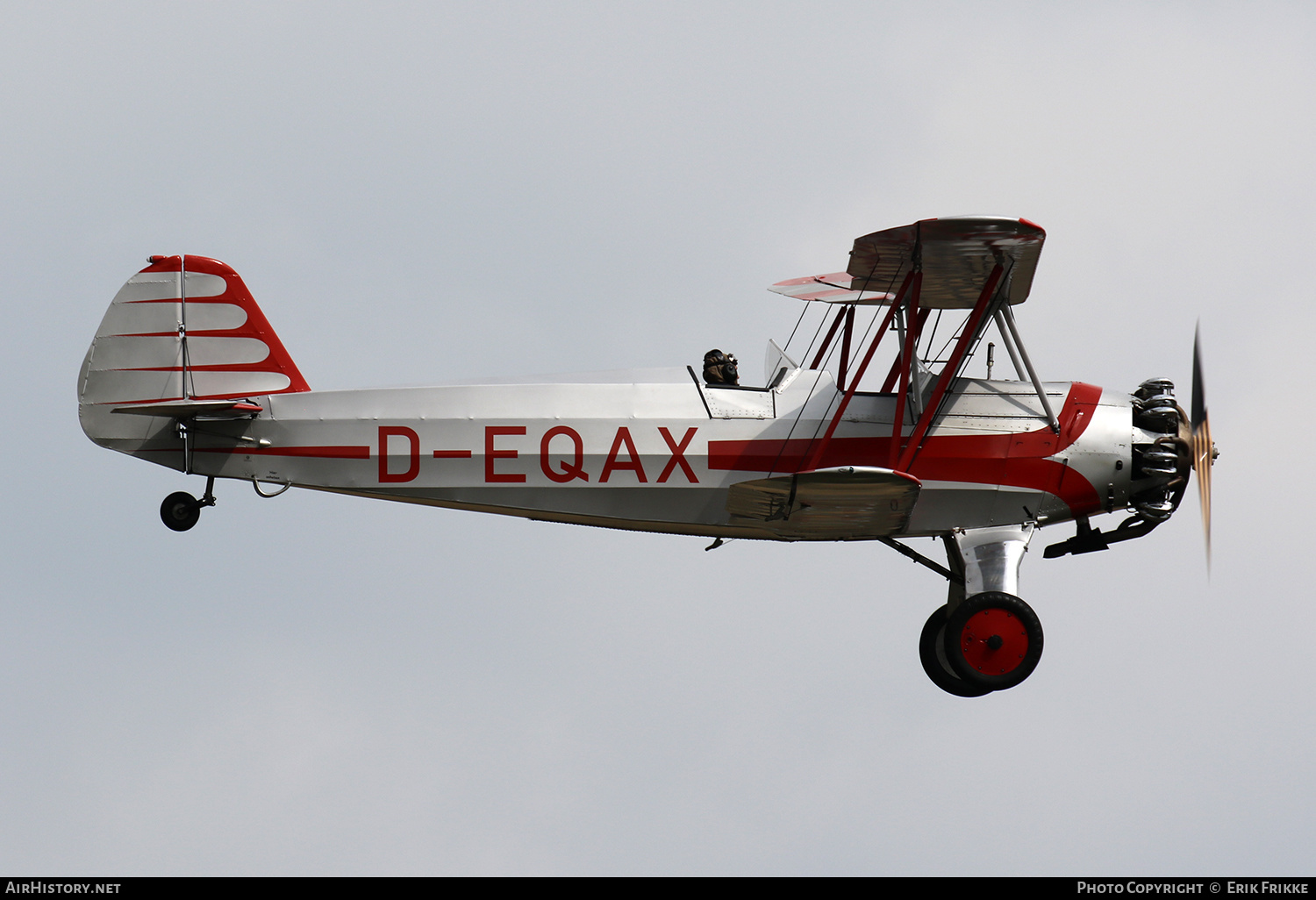Focke-Wulf Fw 44 Stieglitz
Goldfinch from Germany
By Peter de Jong10 November 2021
Deservedly popular today in the airshow circuit, the Focke-Wulf Fw 44 Stieglitz is a bit of a 'wulf' in sheep's clothing. This humble-looking biplane was a world class aerobatic aircraft in its youthful years, before getting serious as a military trainer, churning out thousands of pilots for Hitler's war effort.
A Swedish Fw 44J showing off at the Hahnweide airshow. The Focke-Wolf logo is on the rudder.
Photo: Bernd Weber
Youth friends Heinrich Focke, an engineer, and Georg Wulf, a WWI pilot, had tried to build planes before 1914 and founded an aircraft manufacturing company in their home city of Bremen in 1923. Focke-Wulf was moderately successful with its small airliners, the A16 and A17 Möwe (gull), but faced plenty of competition, with half a dozen German manufacturers building similar aircraft. In 1927, Wulf was killed flying the F19 Ente (duck), an experimental canard aircraft. Focke left the company in 1935 to concentrate on rotorcraft with Gerd Achgelis.
Gerd Achgelis with his Stieglitz in New York. He displayed D‑EPIZ at the National Air Races in 1934 and 1935.
Photo: AirHistory.net Photo Archive
Aerobatic champion
A gifted young pilot, Achgelis won the 1930 German aerobatic championships flying a Focke-Wulf S24 Kiebitz (peewit). This attractive sport biplane had been designed by two Focke-Wulf engineers, Paul Klages and Ernst Wohlberg, in their spare time. Achgelis asked Klages if he could make him an even better aeroplane, and the Focke-Wulf A44 or Fw 44 prototype, D‑2409, was first flown by Achgelis on 5 September 1932. Kurt Tank, soon to be the company's leading light, did not design the Fw 44 but, being in charge of the design bureau and of flight testing, may have played an important part in curing its vices, including a flat spinning tendency when low on fuel which caused the second prototype, D‑2465, to crash on 18 September 1933.
The Stieglitz (goldfinch), as it was named, emerged as an outstanding aerobatic aircraft, with harmonious controls and excellent manoeuvrability. A perfectly traditional mixed-construction biplane, it may not look like a winner in modern eyes, but in 1936 at the Olympic Games in Berlin, where aerobatics was a demonstration sport, Otto von Hagenburg flew an Fw 44 to clinch a unique Olympic title.
Luftwaffe service
Meanwhile, the Fw 44 was in full-rate production as a military trainer, having appeared at just at the right time to play a major role in the buildup of the Luftwaffe. The first production batches had been delivered to civil front organisations in late 1933 and 1934. The Fw 44B and E series were powered by an Argus As 8 inline engine instead of the usual Siemens-Halske Sh 14 radial of about 150 hp. Otherwise, there were only minor differences between the Fw 44 series aircraft, the main marks being the Fw 44D, F and J.
Compared to the very similar Heinkel He 72 Kadett, which had been designed to an official specification for a primary trainer, the Stieglitz was ordered in significantly larger numbers - 768 He 72s were built between 1933 and 1937, whilst 1588 Fw 44s were delivered to the Reich Air Ministry through late 1938. Focke-Wulf itself built 867 of these through March 1938. 515 came out of the Klemm factory in Halle, which became Siebel in 1937. AGO in Oschersleben contributed 121 Fw 44s between March 1937 and March 1938, and 85 more were produced by the new Bücker company in Berlin before its own Bü 131B Jungmann was selected as the Luftwaffe's standard primary trainer in 1936. A more modern biplane, lighter and cheaper, the Jungmann could do much the same job as the Fw 44 on a 100-hp engine. Fw 44 production in Germany proper was thus phased out in 1938.
This did not mean that the type was on the way out in service, since the demands on the Luftwaffe were such that it hardly got to write off any older aircraft that were still in one piece. There were 1385 Fw 44s in the inventory on 30 May 1940, and the Stieglitz contined to equip many of the Luftwaffe's pilot training schools throughout the war.
Export success
The Luftwaffe's Fw 44 fleet actually increased somewhat during the spring of 1940, probably on account of a final export batch of Fw 44Js that Focke-Wulf had built by the ČKD works in Prague following the annexation of Czechia by Nazi Germany in March 1939. 81 Fw 44Js were manufactured in Prague between November 1939 and June 1940, and most were sold abroad despite the outbreak of the war.
The Stieglitz had been earning hard foreign currency for the Reich since 1935. While still a fairly small company, Focke-Wulf actively worked the world markets, offering local assembly or full licensed production, and package deals involving the Fw 44, the Fw 56 Stösser advanced trainer and the Fw 58 Weihe crew trainer. A reliable production total for the Stieglitz cannot be given, but it is safe to assume that 2000 Fw 44 airframes were built in Germany and elsewhere, or at least 2200 if exported aircraft from the German factories were not taken from German Air Ministry orders.
China
The first Fw 44 export order came all the way from China, more precisely from the Canton Provincial Air Arm which was a core element of Generalissimo Chiang Kai Shek's Chinese air force. Achgelis travelled to China with the first three planes, giving flying displays before they were handed over on 29 June 1935. The effort payed off since nine more Fw 44Fs and seven Fw 44Js were ordered and delivered by May 1936. Initially used for fighter pilot training, they were distributed among combat units as liaison planes in the war against Japan and all reportedly lost in action.
Sweden
Another noted aerobatic pilot, Emil Kropf, gave a demo in Sweden, resulting in a military order for two Fw 44Js which were delivered in March 1936. Following successful tests, 14 more aircraft were imported in 1937, receiving the Sk12 designation, while licence production started at ASJA, later Saab, in Linköping. The air force workshops at Västerås, CVV, took over Swedish manufacture in 1939. Twelve ČKD-built aircraft were delivered by Focke-Wulf in 1940. The last of 57 Swedish-built machines were completed by the CVV workshops in 1943, bringing the Swedish total to 85. Replacement by the Swedish-manufactured Bücker Bü 181 Bestmann began already in 1944, but the Sk 12 got a new lease on life as a glider tug and the last aircraft, serial number 670, was not retired from Swedish military service until 1963.
Austria
Austria ordered the Fw 44J in 1936 and 32 aircraft were delivered, of which twelve came from Bremen and 20 were licence-built by the Hirtenberger company at the former Hopfner aircraft factory in Wiener Neustadt. Another 32 aircraft to be supplied by Hirtenberger were not built, or at least not completed before Germany annexed Austria in March 1938. The Fw 44 served with the Schulstaffel (Training Squadron) at Graz - Thalerhof which moved to the new airfield at Zeltweg just before the Anschluss. All 32 Austrian aircraft transferred to the Luftwaffe, although one recently crashed aircraft was scrapped for spares at Erding. Most stayed at Zeltweg where the Austrian flying school reformed as the Flugzeugführerschule Zeltweg.
Turkey
Turkey received tweny Fw 44s in late April 1937. These aircraft were operated by the Turkish Air Leage (THK) rather than the air force. German author Bernd Vetter only mentions eight Fw 44Js delivered in 1940. Some Fw 44s remained in Turkish service until 1963.
Bulgaria
Bulgaria took delivery of 36 German-built Fw 44Js between November 1937 and February 1940. The first four were flown to Bulgaria by Bulgarian pilots in February 1938. A locally produced version was the DAR‑9 Siniger (tomtit) of which 42 examples were built. These were used by the flying school at Kazanlik. Some survivors were refitted to DAR‑9A standard with Czech Walter Minor inline engines in 1948, but despite this upgrade, these may have been outlived by seven unmodified aircraft that were given to Tito's Yugoslavia in 1947 as a gesture of goodwill. The DAR‑9 served in the Yugoslavian air force until 1958, and one machine is preserved in a museum in Zagreb.
Finland
Norway came very close to becoming a Fw 44 operator when it purchased ten of the ČKD-built Fw 44Js in 1940. By March, these aircraft were transferred to Warnemünde to be flown to Oslo by Norwegian pilots via Copenhagen and Gothenburg. An invoice was sent by Focke-Wulf Flugzeugbau on 28 March. Delivery was delayed by the German authorities, however, for reasons that became clear when the German invasion of Norway began on 9 April!
The batch bought originally by the Norwegians became part of a 30-aircraft order from Finland. This order was signed on 11 April 1940. The Norwegian aircraft in Warnemünde were repainted on the spot and the 30 planes were flown to Finland between May 25 and 15 August 1940. They were used by the military flying school at Kauhava. Five additional aircraft were acquired from the Luftwaffe in 1944. The Fw 44 remained in Finnish use until 1960, when 15 survivors were sold on the civilian market. Some six of these remain airworthy today.
The Stieglitz in South America
In 1936, an Fw 44J was sent on a demonstration tour through South America which was particularly successful, resulting in four countries placing orders. The demonstrator, D‑ENOY (c/n 1170), stayed behind in Argentina.
Argentina
Argentina issued a tender for new training aircraft to replace the Avro Gosport in April 1936 and the Fw 44 demonstrator, D‑ENOY, was apparently flown off against a Bü 131 at El Palomar, near Buenos Aires. The Fw 44 was declared the winner and 20 aircraft were ordered, the purchase including D‑ENOY. A licence to build further machines at the Fabrica Militar de Aviones (FMA) in Córdoba was also negotiated, with engines and some structural parts imported from Germany.
The initial 20 aircraft were delivered to the Escuela de Aviación Militar from 9 July through September 1937. Ten of these were assembled by FMA. The first machine claimed to have been manufactured in Argentina already flew on 16 December 1937, and was in fact still a German kit. Eventually, a grand total of 213 Fw 44Js entered Argentinian service, not only with the military but also with state aero clubs.
The import of engines and parts from Germany became difficult in 1940, but the Argentinian industry managed to build a batch of 50 Sh 14 engines under licence, and a batch of 50 Warner Super Scarab radials was obtained from the United States to equip part of the Fw 44 fleet. One Fw 44 was tested with inline engines, an Argus and a De Havilland Gipsy Major II. FMA also developed a Fw 44 variant with a wooden monocoque fuselage to end reliance on steel tubes from Germany. The IAe‑23 first flew in July 1945 when the Argentinian air force was no longer interested. In fact, the Fw 44 fleet was larger than the country needed and many aircraft were in storage. Nevertheless, the final 23 Argentinian Fw 44Js were assembled around 1950 from spare parts, with some re-using construction numbers of crashed aircraft.
The newly independent air force enthusiastically bought Miles Magisters and Percival Prentice trainers from Britain, and although the Fw 44s were generally still in excellent condition, only a small number remained on strength with the air force and the army in the 1950s. In 1956, nine of the last ten still with the air force were scrapped and their fuselage frames chopped into table legs, although the last survivor, serial Ee‑136, soldiered on until at least 1961.
The Argentinian navy received seven new Fw 44s in 1944. They only served until 1947, since the navy preferred the Stearman Kaydet trainer which could then cheaply be bought in ample quantities from US stocks. In Argentinian civil aviation, many Fw 44s continued flying into the 1960, and about ten lasted into the 1970s.
Formerly Ee‑159. As no Fw 44 survived in Brazil, this aircraft was acquired for the TAM Museum in São Carlos, but the museum closed in 2019.
Photo: Paul Seymour
Brazil
A Brazilian naval delegation had been invited to Bremen before the demonstration tour of D‑ENOY. A contract was signed in June 1936 and one Fw 44J arrived in the port of Rio de Janeiro in November 1936. 40 Fw 44Js were assembled in the navy's brand new OGAN workshops at Galeão between May 1937 and July 1938, followed by 25 Fw 58 Weihes. The recipient was the Escola de Aviação Naval. The Brazilian army also received two Fw 44Js in 1939. These came from the FMA production line, having been exchanged with the Argentinians for two Muniz M‑9 trainers of Brazilian design.
In 1941, the creation of the Força Aérea Brasileira meant the dissolution of the naval air arm. Initially the FAB saw no future for the German trainers but, with Brazil declaring war against the Axis powers in 1942, they were used to equip a new reserve officer training centre until spares ran out for the Siemens engines. A few Fw 44s were retained as liaison aircraft until late 1946, while others were given to aero clubs.
Bolivia
A single Fw 44 was delivered to Bolivia in November 1937. The Bolivians also received one Fw 56 Stösser.
Chile
Chile ordered 15 Fw 44s in September 1937 and they were delivered to the country's air force in February 1938. An air display at Puerto Montt on 21 May 1943 did not go well as two Fw 44s collided and crashed, claiming the lives of three of the four occupants. As of 1944, the type still served with the FACh's Escuela de Aviación, but plenty of Fairchild PT‑19 and Vultee BT‑13 trainers had already been supplied by the Americans at that time so the Stieglitz is unlikely to have lasted much longer.The end of the war and beyond
In the Luftwaffe, of course, the Stieglitz continued in service in slowly dwindling numbers until the end of the war. Some Fw 44s were transferred to the puppet state of Slovakia to equip its flying school at Tri Duby (Sliač), and a few of these saw action as liaison planes during the 1944 Slovak National Uprising against the Germans.
One Luftwaffe Fw 44 was flown to Dübendorf, Switzerland on 26 April 1945 by an evading German infantry officer, Maj Arno Albrecht. It was interned and painted in yellow Swiss trainer colours with the serial A‑95, but barely used until sold to a civilian flying school at Birrfeld as a glider tug, HB‑EBN, in 1953. A few captured Fw 44s had also entered the Czechoslovak and Polish civil aviation registers for use as training aircraft for a short while after the war. As described earlier, small numbers of Fw 44 and DAR‑9 aircraft lingered on in military service in several countries until about 1960.
It took some years of postwar prosperity before some private pilots realized that an old open-cockpit biplane might be more fun than a Cessna, and it was a group of Lufthansa employees in the Hanseatischen Fliegerclub (HFC) in Frankfurt who did much to rehabilitate the Fw 44 from its postwar obscurity. From 1972 they flew a former Swedish Sk12 as D‑EMIL (c/n 44). Following a crash in 1977 it was replaced by another former Swede, again D‑EMIL (c/n 87). That Emil was damaged in 1979, but the Lufthansians were repairing their first aircraft and it was registered as D‑EMIL again in 1980.
As of 2021 there are some twenty airworthy Fw 44s. Of these three were built by Focke-Wulf, eight in Sweden, and three in Argentina. The other six were built by ČKD in Prague, and these all served in the Finnish air force The oldest airworthy survivor is probably D‑EQAX, built in Bremen for Sweden back in 1936, and well cared for by its proud owner Claus Cordes at the small Hungriger Wolf airfield near Itzehoe in Schleswig-Holstein.
Presumably the oldest airworthy Stieglitz, built in Bremen for the Swedish air force in 1936.
Photo: Erik Frikke
Specifications Fw 44J
- Capacity: two
- Length: 7.30 m (23 ft 11 in)
- Span: 9.00 m (29 ft 6 in)
- Wing aera: 20,0 m² (215 ft²)
- Powerplant: one Siemens-Halske Sh 14A-4, 119 kW (160 hp)
- Empty weight: 565 kg (1,246 lb)
- Maximum take-off weight: 875 kg (1,929 lb)
- Maximum speed: 185 km/h (1150 mph)
- Cruise speed: 172 km/h (107 mph)
- Range: 675 km (419 miles)
The author would like to thank the good people at the Luftwaffe and Allied Air Forces Discussion Forum for their help in the realisation of this article. The information about the Argentinian Fw 44s is mostly from an article by Santiago Rivas in Small Air Forces Observer, Vol 39 No 3, January 2016.


































































































